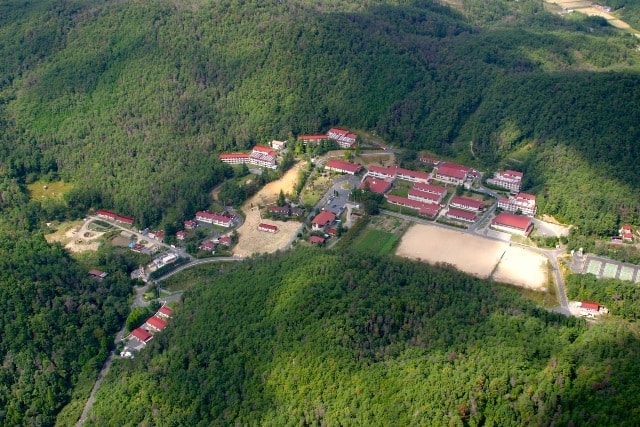
, news editor, Adventist Review
God answering a prayer with a powerful bolt of lightning may sound like a story of biblical proportions, but the principal of a Seventh-day Adventist boarding school in Japan says that’s exactly what happened on his campus.
Hiroshima Saniku Gakuin Academy, a school nestled in rolling hills near Mihara, a city about 45 miles (70 kilometers) east of Hiroshima, faced an urgent water shortage from its aging wells that drove its faculty and 300 students to their knees.
Then a thunderous lightning bolt — complete with billows of yellow and white smoke — rocked the campus one morning, causing several million dollars in damages but also miraculously causing water to gush out of the old wells, principal Shiro Onoue said.
“The water in our wells began to flow immediately after the lightning strike,” Onoue said. “Hallelujah! I know that God helped us.”
Water began drying up at the school’s eight onsite wells several years ago, and the problem became critical during the summer of 2014. The principal, fearing a shortage when classes resumed in the fall, ordered that new wells be drilled on the campus’ hills about 1,500 feet (450 meters) above sea level.
“The campus water is very delicious because it comes from the well-conserved natural groundwater system of Japan,” Onoue said in a statement released by the Adventist Church’s Northern Asia-Pacific Division.
The first two wells came up dry. A third attempt near the end of the summer struck a vein that yielded enough water to meet the campus’ needs. But there was a catch: The well would not be ready to go online in time for classes because various legal procedures and water quality examinations had to be completed first.
Hiroshima Saniku Gakuin Academy reopened as scheduled, and the faculty and students began to pray fervently about the water.
“Every day we prayed to God to guide and protect our water supply,” Onoue said.
The morning of Sept. 4 broke with a cloudy sky and rumbles of thunder in the distance. At 10:55 a.m., five minutes before the students were to stream outdoors on a break between classes, an ear-piercing explosion rattled the campus.
Onoue was sitting in the principal’s office, working with his back to the window.
“I quickly turned to the window to see what had happened,” he said. “There was yellow and white smoke coming out from behind the gym, and I knew that lightning had struck.”
Buildings went dark as the electricity failed across the campus. Onoue immediately called the gym and was relieved to hear that everyone there was safe. He ordered the students to stay indoors as the adults investigated the extent of the damages.
It turned out that the lightning had not hit the gym but a mobile phone antenna near a tennis court outside the building. Chunks of concrete debris from atop the antenna lay scattered on the ground after being blown off by the lightening bolt.
The electricity was restored in the afternoon, but other problems surfaced in the following days. Water pumps, extension phone systems, street lights, campus emergency broadcasting systems, and boiler systems in faculty houses had all been damaged by the lightning.
“It was a great headache to even think about the cost of repairing all the damages to our campus,” Onoue said.
Total repairs ended up costing the equivalent of US$5 million — all thankfully covered by the school’s insurance.

But faculty and staff members began to find many positive things as they considered the destruction. That summer, the school had replaced all the computers in its computer lab with new models purchased by the Northern Asia-Pacific Division, and not one of them was damaged. While boilers were damaged in the faculty houses, the only ones that wound up requiring replacement were old and in need of repair anyway.
Then a campus maintenance worker alerted Onoue that something had happened to the campus’ water supply. Worried, Onoue asked whether the water had stopped finally.
“No,” the worker replied. “The wells that were not producing water are now beginning to yield more than double the amount as before!”
Onoue could not believe his ears. He asked whether the water meter had been damaged and was giving the wrong reading. The worker said that was his initial concern, too, and he had double-checked the gauges and found them to be accurate.
Onoue said a lightning strike that had initially looked like a terrible disaster had turned out to be a miracle from God.
“This one-time burst of energy from the lightning allowed us to upgrade all the old systems to new ones,” he said. “Most of all, we are grateful for being able to experience firsthand God’s miraculous work of allowing lightning to strike the water vein and provide enough water for our campus.”
A year has now passed since the lightning, and the school has not faced any water shortages. The newly drilled well is now ready for use.
Onoue said the incident has encouraged faculty and students in their belief that God is guiding Hiroshima Saniku Gakuin Academy, which traces its roots to a Bible school that opened in Tokyo in 1898. The school’s Japanese name means “threefold educational school,” referring to the mental, physical, and spiritual aspects of an Adventist education.
Onoue said he found comfort in the words of the apostle Paul in 1 Corinthians 15:58: “Therefore, my dear brothers and sisters, stand firm. Let nothing move you. Always give yourselves fully to the work of the Lord.”
“Through this experience, we are once again assured that Hiroshima Saniku Gakuin is indeed a school that God intentionally built,” Onoue said.